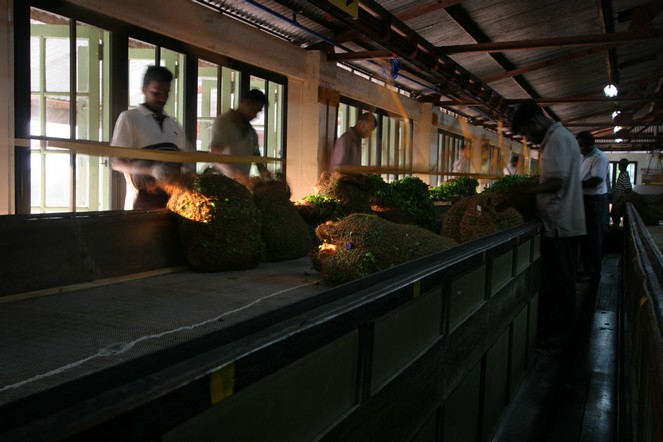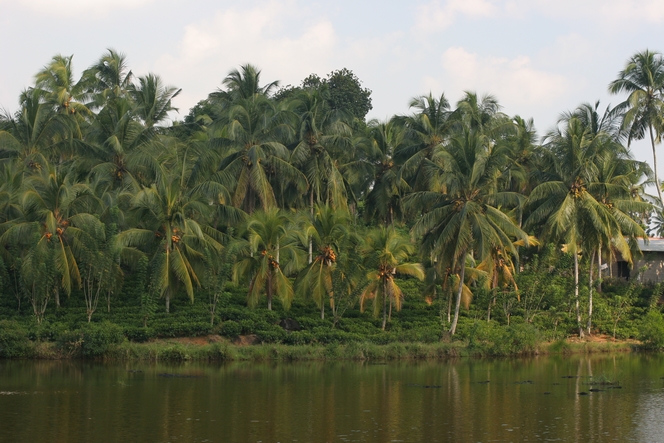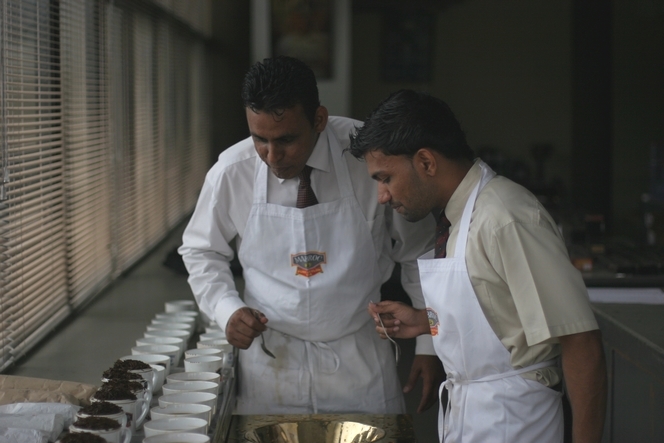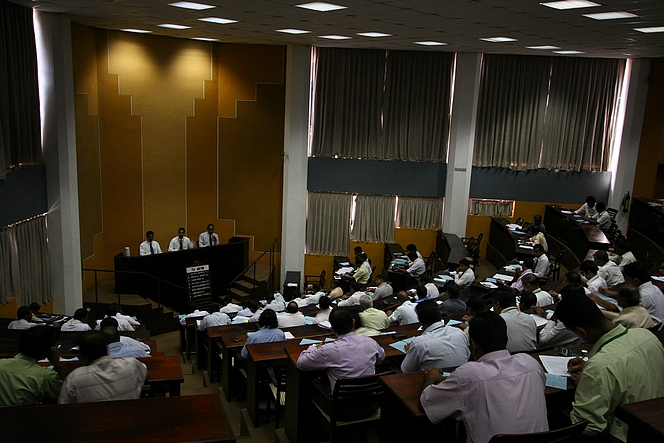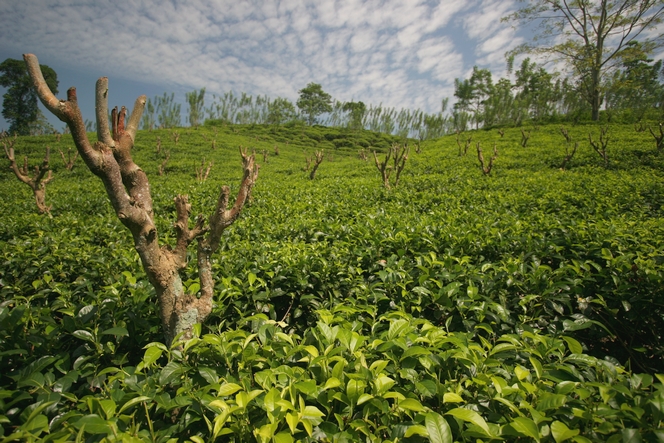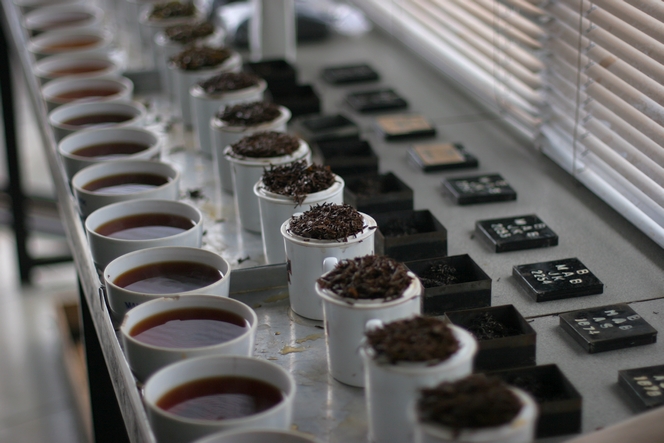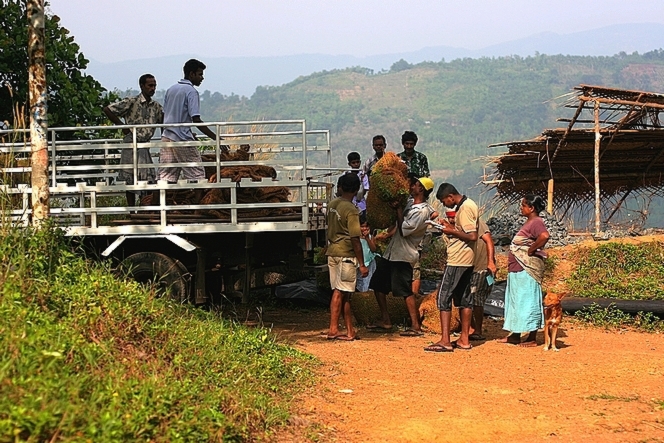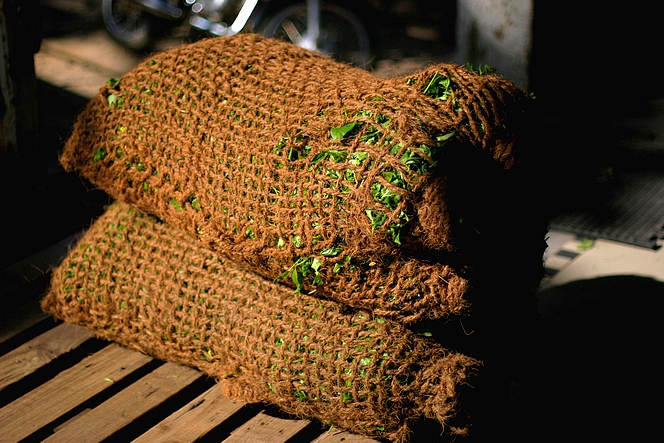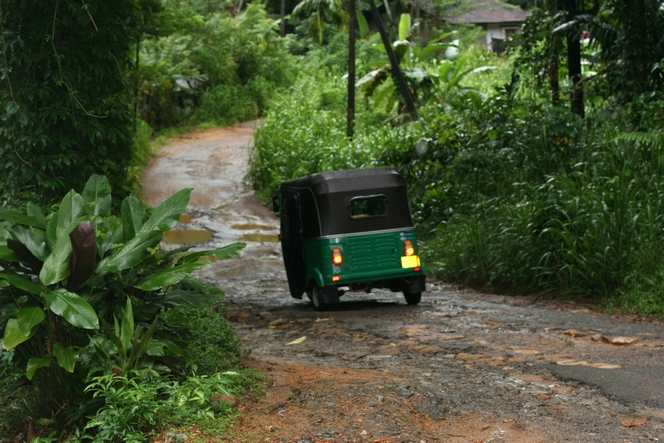The low sun illuminates these bags filled with freshly plucked tea leaves, creating a contrasting effect of light and shadow. The men work quickly, emptying the bags and spreading the leaves out on withering trays, so that there is no risk of them fermenting.
In some regions of Sri Lanka, tea is harvested at this time of year.
Sri Lanka
Palm trees giving shade to tea plants
Here, in the south of Sri Lanka, in the “low grown teas” region, the sun is very intense, and it is best to protect the tea plants from its rays for at least a few hours a day.
Curiously, palm trees are used here to provide shade, despite being a rarity. As the palm trees themselves are cultivated, this enables the farmer who owns this lovely lakeside plot to harvest two different products on the same land, and both plants benefit.
Tea tasting with Dilan and Vidusha
Last week, in the company of Dilan Wijeyesekera and Vidusha Wakista, I tasted teas from the regions of Dimbula, Uva and Nuwara Eliya, side by side.
Dilan and Vidusha work for the company Mabroc and supply some of our teas from Sri Lanka, which come either from their own plantations or the Colombo auctions.
We also discussed “low growns”, teas from the south of the country that grow at a low altitude, and which have steadily improved in quality over the years. Most low tea plantations don’t use the rotorvane, a machine widely used on high grown plantations, which handles the leaves more roughly than the orthodox procedure.
In Colombo, weekly tea auctions are held
I am writing this in Colombo, in the room where the weekly tea auctions are held. In fact there are many auction rooms like the one I’m sitting in now, where different grades are sold.
The three people you see on the platform are brokers. In the days preceding the auction they will have received hundreds of samples from the tea plantations. They print a catalogue listing all the lots of tea available, which they send to the exporters, and today they are selling the teas.
The men sitting in this room – strangely there are no women – are exporters. They are officially recognised as such, and are almost the only people with the right to export tea from Sri Lanka.
What amuses me about this photo is that everyone seems so calm, whereas in reality the place is buzzing with activity. The man in the centre of the platform is announcing the lots to be sold and is speaking at an incredible rate. A few seconds later he brings the hammer down and moves on to the next sale. He spots a man raising an eyebrow, which means he is bidding higher, or another lifting a finger, and when nobody else moves, it means the deal is done.
On a tea plantation, trees need to be pruned too
On a tea plantation, tea plants are not the only ones that need care and attention: the trees do too. If you want their leaves to give a little shade to the camelias, the trees have to be prevented from growing too tall. So from time to time, they have to be pruned severley, like here near Ivy Hills (Sri Lanka), to be kept low and start up again with renewed vigor.
To select a tea, you have to taste dozens
When we attend professional tea tastings, there is a great number of teas to assess. It can range from three or four to several dozen. Sometimes the teas we taste are all quite similar, like here in Colombo (Sri Lanka). They come from the same area, and you go from one to another, comparing them in turn. First you smell the various infused leaves, then you examine each liquor. In the trade jargon, we call the infused leaf an “infusion”, and the contents of the cup, the “liquor”. (To know more about it: see the article To choose tea, you need to have a good nose).
The dry tea leaf is also presented so that you can look at it, feel and touch it, and get a complete picture of the particular batch you are tasting.
Tea leaves that are worth a detour
In the south of Sri Lanka, tea is mostly grown by individual farmers who cultivate their own land. They sell the tea leaves just after the harvest, as they don’t have the infrastructure to process them. The farmers don’t have to go far to find buyers: their freshly plucked tea leaves are very much wanted by the local tea factories, who even go and collect the bags filled with fresh tea leaves themselves because of competition.
I spent hours going round the farms in one of these 4x4s fitted out with trays and it’s an incredible experience: we sometimes had to get the bags high in the mountains, skidding on the steep slopes, driving along vertiginous drops, crossing forests under cries of monkeys. We’d then suddenly end up on the top of a mountain in the middle of nowhere, around farmers breeding cattle and living out of different cultivations.
So we’d buy the tea leaves, chat a little, maybe drink a tea together. We’d talk. We’d laugh. And it’d then be time to go and collect more tea bags from other isolated farms.
Tea is in the bag
What a beautiful warm evening light illuminating these string bags filled with fresh tea leaves. This is happening in Dellawa (Sri Lanka). In a few minutes, these leaves will be taken to the top floor of the tea factory where they’ll undergo the first stage of processing: withering. A stage that can take up to 20 hours for this type of black tea and consists simply in remaining the leaves spread out in thin, long and well ventilated trays. Water will thereby be taken out of the fresh tea leaves.
In a tuk-tuk through the jungle of Sri Lanka
I don’t know which means of transportation you took to get to work this morning. As for me, I didn’t really feel like walking that day. It had just poured masses of water and I feared that it would start again. So in this jungle close to the forest reserve of Sinharâja in the South of Sri Lanka, nearby the plantations where you find the best FBOBEXSP teas (grade that defines the finest teas), I hailed a tuk-tuk. For several kilometers, I followed a small road and zigzagged between the puddles. The air was warm. Thanks to the smell of wet earth and ripe fruits, my trip to the Tea Factory become an amazing olfactory journey.
Tea trees looking like traffic lights
At New Vithanakande (in the south of Ratnapura, Sri Lanka), to keep the tea plants at the right height, the trees serve as a kind of traffic light system: if you see green, the tea plant is not too high, if the green disappears it is the orange that shows, and the plants need to be cut lower, and if only the red shows, things have got out of hand!

